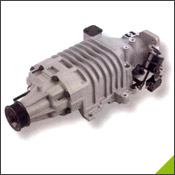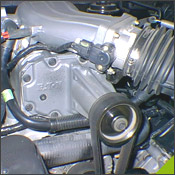SUPERCHARGING & ELECTRIC SUPERCHARGERS
 Forced Induction Forced Induction
You probably know that in an automobile engine the pistons go up and down, and this makes the wheels go round and round. It's the down stroke that sends the driving force to the wheels, and the more powerful the down force, the more horsepower you have.
The way to get more powerful down force is to have a more powerful explosion at the top of the piston, and the way to do this is to force more air and fuel into the cylinder at each cycle.
Normally aspirated engines draw in outside air by the vacuum caused by the piston going down as the vapour in the cylinder is exhausted. If you push more air in, and compress it so it's more dense, the explosion increases. Force-feeding the engine in this way is Forced Induction, the general name for the whole family of turbo charging and supercharging devices designed to boost the engine power.
The science of air compression and pumping was in use before the internal combustion engine was invented.
Forced induction as applied to automobiles is a simple concept: put an air pump into the fuel-air delivery system to force in more air under pressure so the denser air in the cylinder makes a bigger bang per cycle. The basic requirement is to pump air faster than the engine does, but the complications come with the need to do this across the whole range of rpm, and without absorbing too much of the extra power produced, and especially without producing too much extra heat, because heat is bad for the engine and more significantly, prevents the very density you want to achieve.
 How does supercharging increase engine performance? How does supercharging increase engine performance?
Superchargers achieve performance gains by increasing the density of the air/fuel charge within the combustion chambers of an engine. This increase in density is achieved by forcing additional amounts of air (beyond the amount of air that normal atmospheric pressure would force into the engine) at the lowest temperature possible. CFM measures the volume of air that an engine is flowing, while MAF (mass air flow) also factors in the temperature of the air charge, since a cooler charge is more dense and therefore more powerful. So in more technical terms, supercharging increases both the volumetric efficiency of the engine and the mass air flow through the engine to produce gains in both horsepower and torque.
How much horsepower will a supercharger add to my engine?
Although some manufacturers claim a specific horsepower increase, superchargers actually add horsepower as a percentage gain (percentage of an atmosphere). Assuming an engine with a compression ratio of around 9:1 running pump gas, if a supercharger gives your engine 14.7 psi of boost (another atmosphere) that will essentially double the output of your engine, everything else being equal. After adjusting for thermal and mechanical energy transfer, if an efficient centrifugal supercharger is generating 7.5 psi (approx. 1/2 an atmosphere), you will see around a 35-40% gain in horsepower and torque at your non-supercharged maximum horsepower rpm. If detonation forces you to use an ignition/timing retard system, you will of course see less of a gain because backing off several degrees of timing will greatly reduce an engine's power output. At higher boost levels, the heat generated by compressing air will produce diminishing returns as the boost is increased, although the use of inter cooling or racing fuel can avoid this scenario of diminishing returns. Assuming the use of inter cooling to run higher boost levels while maintaining reliability, a 100% increase can generally be achieved at around 17 psi on an engine with 9:1 compression running pump gas.
Why has supercharging become so popular?
There are a number of reasons. First, an efficient supercharger system can produce yesterday's musclecar performance using today's low-octane gasoline, with exceptional reliability and minimal impact upon fuel economy. Second, superchargers have developed to the point that they are easy to install and simple to maintain, especially when compared to pulling, rebuilding and fine-tuning an engine. Finally, unlike nitrous oxide, which requires frequent repurchase of fuel, once a supercharger is installed there is no more expense or hassle associated with performance. In short, supercharging delivers exceptional performance with little of the hassles traditionally associated with high performance. Centrifugal supercharging is the only way to make a reliable 500, 600, 700+ horsepower on otherwise stock, daily driven V-8's.
What type of fuel do I need with a supercharged automotive or truck engine?
The primary issues that determine the type of fuel needed are whether the engine is fuel-injected or carburetted, the compression ratio of the engine, and whether or not the supercharger system is intercooler.
For Intercooler Supercharger EFI/TPI applications with compression ratios less than 9.5:1, boost levels of 14-17 psi can be safely run with full timing on pump gas, and will produce horsepower gains of 75-100% (depending upon the boost level and the motor specifications). For 9.5:1 EFI/TPI applications running without an intercooler, boost levels above 5 psi will require the use of ignition/timing retard on pump gas, and will produce horsepower gains of 35-45%. Boost levels above 12 psi should generally be avoided even with racing fuel on a 9.5:1 motor. Of course, lower compression motors will be able to run more boost, and higher compression motors should run less boost, everything else being equal. All Intercooler Supercharger systems for street applications are designed to allow the use of pump gas with full timing and will not affect daily drivability.
For carburetted motors, the rules are slightly different. Carburettors deliver the vast majority of fuel in a liquid state, and as this raw fuel atomizes from liquid to gas, a chemical state change actually occurs. Due to this endothermic reaction, which draws heat and cools the incoming air, a carburetted motor can safely handle more boost than a comparable EFI/TPI motor. For carburetted engines with compression ratios of 9:1 or less and boost levels in the 8-14 psi range, pump gasoline works very well. Compression ratios of 10:1 and higher require lower boost levels, higher octane fuel, inter cooling, or some combination of the above. Compression ratios in the 7or 8:1 range can usually handle 12-20 psi on pump gasoline.
What is detonation, and how can it be controlled?
Detonation, or engine knock, occurs simply when fuel pre-ignites before the piston reaches scheduled spark ignition. This means that a powerful explosion is trying to expand a cylinder chamber that is shrinking in size, attempting to reverse the direction of the piston and the engine. When detonation occurs, the internal pneumatic forces can actually exceed 10x the normal forces acting upon a properly operating high performance engine. Detonation is generally caused by excessive heat, excessive cylinder pressure, improper ignition timing, inadequate fuel octane or a combination of these. Of the previous, excessive heat is usually the culprit. As an engine is modified to generate more power, additional heat is produced. Today's pump gas will only tolerate a finite amount of heat before it pre-ignites and causes detonation. Although forced induction engines usually produce far less heat than comparable naturally aspirated high compression engines, the cylinder temperatures in inter cooled engines are radically cooler yet. It is rarely boost that causes detonation, just unnecessary heat. An intercooler is such a natural solution for forced induction, that in almost every sophisticated application, inter cooling is part of the package.
For engines that are experiencing detonation problems, the primary options are the use of ignition/timing retard systems, higher octane fuel, or inter cooling. While ignition retard systems can be helpful in certain situations, they can also greatly reduce the horsepower output of an engine, as any reduction in timing will reduce horsepower. And while a reduction in timing can save a motor from detonation, the excessive heat which was causing the detonation is still present. Inter cooling, on the other hand, actually removes the heat which causes detonation, and allows higher boost levels to be safely run with full timing on pump gas. This produces the maximum benefit in terms of both horsepower gains and engine protection, without any additional maintenance or hassle.
How will a supercharger affect my fuel economy?
Although roots superchargers have significant parasitic load and do dramatically decrease fuel economy, centrifugal superchargers will yield approximately the same fuel economy as normally aspirated engines, under normal throttle conditions. When racing, however, fuel economy will decrease given the supercharged engine's ability to consume additional fuel and produce additional horsepower.
Will a supercharger shorten the life of my engine or drive train?
That is a very subjective question, as the manner in which an automobile is driven directly affects engine life. Assuming a properly tuned system, proper oil change and engine maintenance, and similar driving, supercharging generally will not shorten the life of an engine, just as is the case with OEM turbo charging (with proper cool down for turbochargers. A cool down period after driving is not necessary with supercharging). This is especially true of centrifugal supercharging, which generates boost in line with engine rpm, unlike roots and twin screw blowers, whose low rpm boost can place additional strain on the engine and drive train.
Superchargers can be used with automatic or manual transmissions and will not increase transmission wear under normal driving. When racing, however, the additional torque provided by supercharging will place additional load on the transmission, especially when increased traction is present, such as with slicks. This impact is minimized when the boost increases with engine rpm, as is the case with centrifugal supercharging and turbo charging.
|
